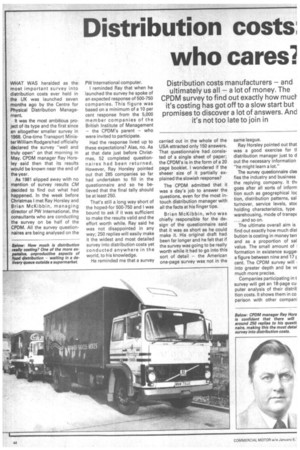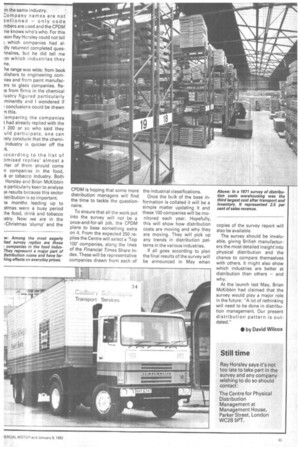Distribution costs who cares?.
Page 38

Page 39

If you've noticed an error in this article please click here to report it so we can fix it.
Distribution costs manufacturers — and ultimately us all — a lot of money. The CPDM survey to find out exactly how muc[ it's costing has got off to a slow start but promises to discover a lot of answers. And it's not too late to join in
WHAT WAS heralded as the most important survey into distribution costs ever held in the UK was launched seven months ago by the Centre for Physical Distribution Management.
It was the most ambitious project of its type and the first since an altogether smaller survey in 1968. One-time Transport Minister William Rodgers had officially declared the survey "well and truly open" on that morning in May. CPDM manager Ray Horsley said then that its results would be known near the end of the year.
As 1981 slipped away with no mention of survey results CM decided to find out what had happened. In the week before Christmas I met Ray Horsley and Brian McKibbin, managing director of PW International, the consultants who are conducting the survey on be half of the CPDM. All the survey questionnaires are being analysed on the
PW International computer.
I reminded Ray that when he launched the survey he spoke of an expected response of 500-750 companies. This figure was based on a minimum of a 10 per cent response from the 5,000 member companies of the British Institute of Management — the CPDM's parent — who were invited to participate.
Had the response lived up to these expectations? Alas, no. As at that date just before Christmas, 52 completed questionnaires had been returned. However, Ray Horsley pointed out that 285 companies so far had undertaken to fill in the questionnaire and so he believed that the final tally should be at least 250.
That's still a long way short of the hoped-for 500-750 and I was bound to ask if it was sufficient to make the results valid and the effort worth while. Ray said he was not disappointed in any way; 250 replies will easily make it the widest and most detailed survey into distribution costs yet conducted anywhere in the world, to his knowledge.
He reminded me that a survey carried out in the whole of the USA attracted only 150 answers. That questionnaire had consisted of a single sheet of paper; the CPDM's is in the form of a 20 page booklet. I wondered if the sheeer size of it partially explained the slowish response?
The CPDM admitted that it was a day's job to answer the questions, even for the most intouch distribution manager with all the facts at his finger tips.
Brian McKib bin, who was chiefly responsible for the design of the questionnaire said that it was as short as he could make it. His original draft had been far longer and he felt that if the survey was going to be really worth while it had to go into this sort of detail — the American one-page survey was not in the same league.
Ray Horsley pointed out that was a good exercise for tl distribution manager just to d out the necessary information "he might learn a lot."
The survey questionnaire clas fies the industry and business the replying company. It thi goes after all sorts of inform tion such as geographical loc tion, distribution patterns, sal turnover, service levels, sto( holding characteristics, type warehousing, mode of transp( ....and so on.
The ultimate overall aim is find out exactly how much dist bution is costing in money terr and as a proportion of sal value. The small amount of formation in existence sugge: a figure between nine and 17 cent. The CPDM survey will into greater depth and be VE much more precise.
Companies participating in t survey will get an 18-page cu puter analysis of their distrit tion costs. It shows them in co parison with other compam m the same industry.
Company names are not entioned — only code mbers are used and the CPDM ine knows who's who. For this ison Ray Horsley could not tell which companies had alicly returned completed ques nnaires, but he did tell me irn which industries they ne.
'he range was wide; from book alishers to engineering con lies and from paint manufac ers to glass companies. Re's from firms in the chemical
lustry figured particularly ,minently and I wondered if r conclusions could be drawn -n this.
:omparing the companies t had already replied with the t 200 or so who said they uld participate, one can rely conclude that the chemiindustry is quicker off the rk.
■ ccording to the list of omised replies' almost a rter of them should come n companies in the food, ik or tobacco industry. Both Horsley and Brian McKibbin e particularly keen to analyse results because this sector istribution is so important, le months leading up to stmas were a busy period the food, drink and tobacco istry. Now we are in the :-Christmas 'slump' and the CPDM is hoping that some more distribution managers will find the time to tackle the questionnaire.
To ensure that all the work put into the survey will not be a once-and-for-all job, the CPDM plans to base something extra on it. From the expected 250 replies the Centre will select a 'Top 100' companies, along the lines of the Financial Times Share Index. These will be representative companies drawn from each of the industrial classifications.
Once the bulk of the base information is collated it will be a simple matter updating it and these 100 companies will be monitored each year. Hopefully, this will show how distribution costs are moving and why they are moving. They will pick up any trends in distribution patterns in the various industries.
If all goes according to plan the final results of the survey will be announced in May when copies of the survey report will also be available.
The survey should be invaluable, giving British manufacturers the most detailed insight into physical distribution and the chance to compare themselves with others. It might also show which industries are better at distribution than others — and why.
At the launch last May, Brian McKibbin had claimed that the survey would play a major role in the future: "A lot of rethinking will need to be done in distribution management. Our present distribution pattern is outdated."
• by David Wilcox










































